
 |
|
|
#1 |
|
Arms Historian
Join Date: Dec 2004
Location: Route 66
Posts: 10,748
|
Interested in finding out more on native American arrows, and am hoping there are some collectors or enthusiasts out there interested in this little discussed sector of ethnographic weapons. It seems that as in most ethnographic material culture there is considerable emphasis on symbolism. I am wondering about arrows in particular, and have found that various tribes used certain markings or distinguishing characteristics that would identify an arrow as belonging to a certain owner. This was of course key in hunting, and would determine the owner of the game brought down.
Can anyone elaborate more on this practice, maybe even describe key markings such as colored bands on shafts or marks etc. ascribed to certain tribes? Any recommended resources that might offer information on this subject? Thanks very much, Best regards, Jim |
|
|

|
|
|
#2 |
|
Member
Join Date: Mar 2005
Location: Austin, Texas USA
Posts: 257
|
Jim,
I am interested, but hardly knowledgeable. Here is an illustration of a beaded Sioux bag c. 1880 and "a selection of Plains Indian hunting arrows" not further identified. Source: The Peacemakers: Arms and Adventure in the American West by R.L.Wilson, Random House, New York (1992). Wilson notes: "Bows and arrows present difficulty in dating since they changed little over generations." Obviously the pictured arrows date from after the introduction of iron and steel into the Western Hemisphere, but indigenous stone points and metal probably coexisted for centuries as well I would think. I hope we do have some experts who can provide more information. Berk |
|
|

|
|
|
#3 |
|
Arms Historian
Join Date: Dec 2004
Location: Route 66
Posts: 10,748
|
Hi Berk,
Thank you so much for the response and for the excellent reference. The point made about the dating of bows and arrows is well made, and it is apparant that each tribe carried its own traditions in degree for indeterminate periods of time. It seems that the description of the meaning of certain symbolisms is often conflicting in various resources also. I too am hoping that someone out there may be well versed in the study of the weapons of this fascinating culture, and may be willing to share that knowledge here. All best regards, Jim |
|
|

|
|
|
#4 |
|
Member
Join Date: Dec 2004
Location: B.C. Canada
Posts: 473
|
Hi Jim and Berk,
I think Evan S. Connell went into some detail on the variations between the nations and tribes in his book Son of the morning star . Damned if I can find my copy to confirm this! Regarding the use of iron arrow heads Joseph M. Marshall III in his book The day the world ended at Little Bighorn first edition on Page 98 "Around 1840, the Lakota had fairly consistent access to iorn in the form of metal pots, the flat hoops from wooden barrels and wagon wheel rims. Some of that material was acquired in trade or after white people had discarded it. Iron was used by the Lakota to make knives, lance points, and arrowheads for hunting and warfare. The iron was either melted down or cut with a cold chisel or, if available, a hacksaw. The consistent availability of iron was a benefit to the Lakota because they could make knives and projectile points with it faster than ones from stone. (After 1850, the skill to make stone projectile points began to be a lost art.) ...I have seen a few other articles on this topic and will look this week to see what else I can add. All the Best Jeff |
|
|

|
|
|
#5 |
|
Arms Historian
Join Date: Dec 2004
Location: Route 66
Posts: 10,748
|
Hi Jeff,
Definitely an outstanding book! Wish I had my copy handy too  Excellent info on the use of iron by the Lakota. It seems amazing how effective the Plains Indians were with the bow and arrow. Thank you very much for the reference on that....look forward to what else you might find. All the best, Jim |
|
|

|
|
|
#6 |
|
Member
Join Date: Aug 2005
Location: Heidelberg/Germany
Posts: 9
|
Hello dear Jim,
I guess, I shall find some information in my library. Don't think this will become a riddle. Many greetings! Ronald |
|
|

|
|
|
#7 |
|
Member
Join Date: Dec 2004
Location: What is still UK
Posts: 5,941
|
I am waiting for a customer to call which has given me some time to play with. These are extracts from "Indian & Eskimo Artifacts of North America" 1962, Charles Miles, Bonanza. It is available from USA amazon and silly cheap, you are daft if you do not order one. These are the pics of the more recent arrows.
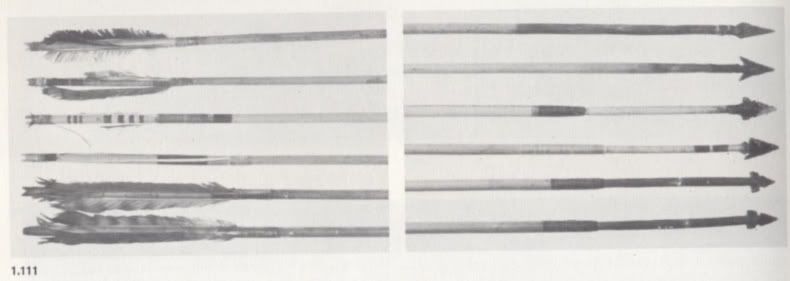 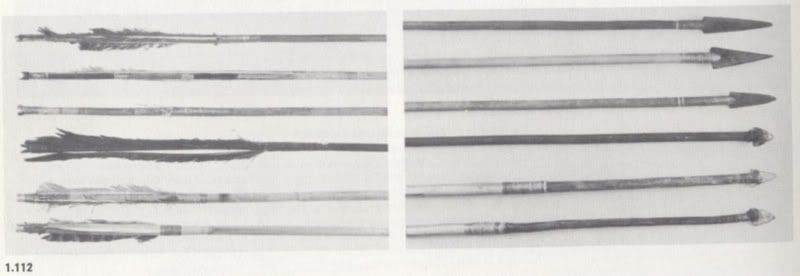 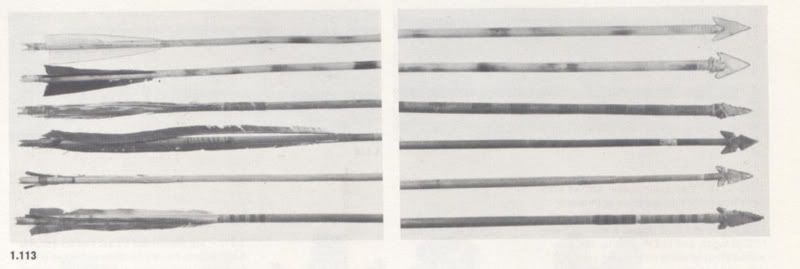  
|
|
|

|
|
|
#8 |
|
Member
Join Date: Dec 2004
Location: What is still UK
Posts: 5,941
|
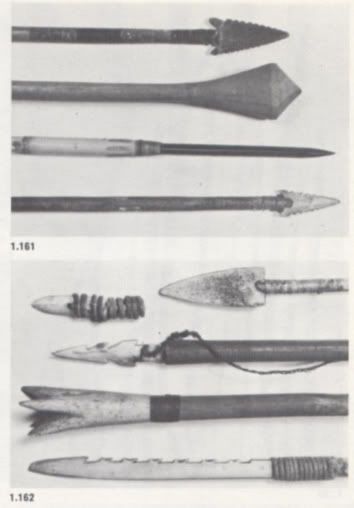 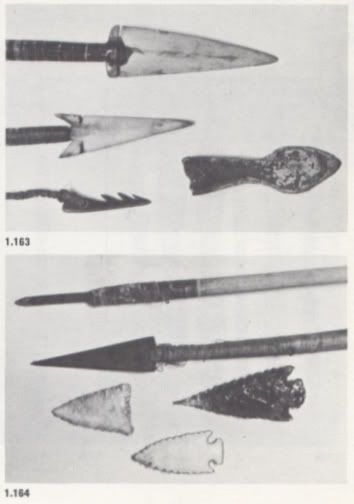 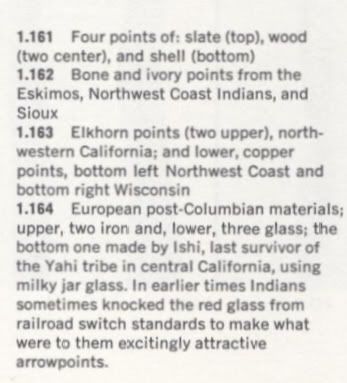
|
|
|

|
|
|
#9 |
|
Member
Join Date: Dec 2004
Location: What is still UK
Posts: 5,941
|
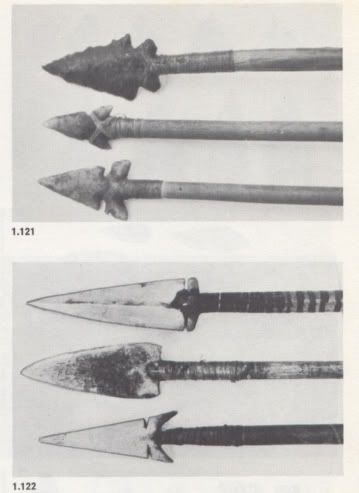 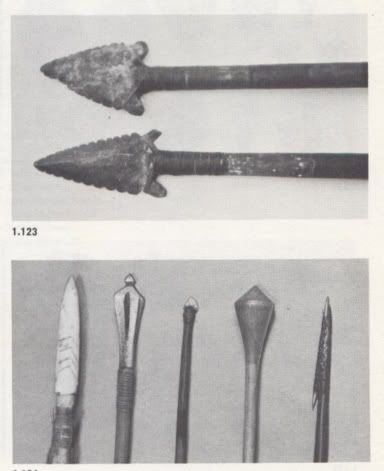 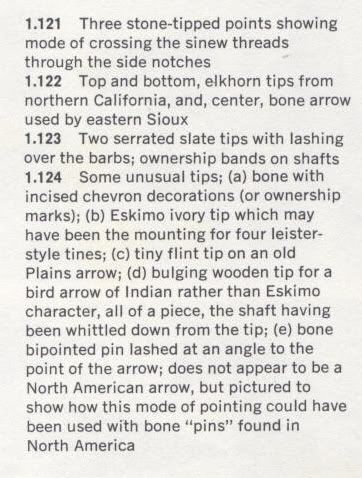
|
|
|

|
|
|
#10 | |
|
Member
Join Date: Mar 2005
Location: Austin, Texas USA
Posts: 257
|
Quote:
 Just ordered a used copy from the closest source (not even the lowest price) for less than a hamburger and fries! Thanks. Just ordered a used copy from the closest source (not even the lowest price) for less than a hamburger and fries! Thanks.Berk |
|
|
|

|
|
|
#11 |
|
Arms Historian
Join Date: Dec 2004
Location: Route 66
Posts: 10,748
|
Excellent resource Tim! Thank you so much for posting the illustrations as well. It seems that the shape and material used in the heads does differ quite a lot between varying tribes, and that certainly would be key in identifying certain arrows. I can always remember watching old western movies where the grizzled old wagonmaster would pick up an arrow and pronounce, "yup, thats a Cheyenne arrow allright!". I was completely intrigued by how this guy could simply look at an arrow and know instantly what tribe it was from. Naturally, Hollywood elaborated and embellished these dramatics, but even in my wide eyed young naievete, I knew that there were many distinguishing differences between tribes in both dress and weaponry.
In recent visits to locations where many of these tribes are still situated, my interest has been greatly rekindled from the somewhat latent interest that has remained all these years. While studying the ethnographic weapons of so many other countries for so many years, I have suddenly realized the wealth of history here in my own backyard! Hi Ronald! Its so great to have you post on this, and I know you will find something in that library of yours!!!  It has always amazed me that there has always been a strong fascination in Europe, especially Germany, for our 'wild west' and I believe there is good literature on the topic there. It has always amazed me that there has always been a strong fascination in Europe, especially Germany, for our 'wild west' and I believe there is good literature on the topic there.Looking forward to hearing more!!! All the best, Jim |
|
|

|
|
|
#12 |
|
Member
Join Date: Dec 2004
Posts: 1,247
|
One of my real favorites on the topic of archery is the Traditional Bowyer's Bible series, particularly the first volume. In the first volume is a great article on western Indian arrows.
Note that these books are really for people who want to make traditional bows and arrows, not collectors. They won't directly help you authenticate a piece. They will help you determine whether the arrow is authentic in the sense that it would fly straight, what use it was designed for (like the skipping arrows used for hunting waterfowl in the western US), etc. The first volume in particular focuses on native american bows and arrows, but subsequent volumes talk about archery on other continents. Also, these should be available from Amazon. My 0.02 cents, F |
|
|

|
|
|
#13 |
|
Arms Historian
Join Date: Dec 2004
Location: Route 66
Posts: 10,748
|
Thats a great 2 cents Fearn! I know that bows and arrows are still being made following authentic traditions, so it makes perfect cents
 that good information would be found there. that good information would be found there.I am curious if there was tribal or symbolic significance to the colored bands sometimes seen on the shaft, and it seems in one museum I once saw some arrows that had I think green bands. Unfortunately cannot recall where my scribbled notes went, but I think the tribal affiliation was noted. Best regards, Jim |
|
|

|
|
|
#14 |
|
Member
Join Date: Dec 2004
Location: What is still UK
Posts: 5,941
|
As we have a world wide viewing I thought it might be helpful to add this. Ishi is mentioned in the section about Californian arrows so look at this http://en.wikipedia.org/wiki/Ishi
Also I think the last official USA conflict with its native people was with Mashoni Mike in 1913. I might be wrong as i have had to sell lots of books in the past before a got a stable home. Not Mashoni it is Shoshone I said it was sometime ago that I had the books. |
|
|

|
|
|
#15 |
|
Member
Join Date: Dec 2004
Posts: 1,247
|
Hi Jim,
You're quite welcome. So far as I know, the green bands have two uses, depending on which end of the arrow they are on. If the bands are near the head, they can have two uses: to help the archer determine he has hit the optimal draw length (this is also sometimes done by putting a loop of thread around the arrow at that point so it can be felt, and (if the entire foreshaft is darkened) to camouflage the arrow somewhat (if hunting from a blind, for instance). Marks on the end of the arrows are simply to identify whose arrow it is. If several people are hunting, this helps determine who killed something. In some groups, every hunter had his own colors. F |
|
|

|
|
|
#16 |
|
Arms Historian
Join Date: Dec 2004
Location: Route 66
Posts: 10,748
|
Hi Fearn,
That is good information and the placement of a mark to indicate draw length seems logical, but the use of colored bands or markings to identify either tribe or individual is more what I'm trying to locate. I found this referenced from "Plenty Coups: Chief of the Crows" (Frank Bird Linderman, 2002) ; "...all arrowheads were marked...the men of the tribe knew each others arrows by the marks". "...the marking of arrows was not only individual, but tribal. The Crows call the Cheyenne 'the striped feather arrows' because of the barred feathers of the wild turkey usedon thier arrow shafts. Even the sign name for the Cheyenne was conceived from these feathers. It is made by drawing the right index finger several times across the left, as though making marks on it. " Also, supporting the concept of claiming fallen game, James H. Howard in "The Ponca Tribe" (1995) writes, "...it was a custom of the Ponca tribe for each gens to have its peculiar manner of marking arrows, so there should be no dispute in hunting as to the gens to which a fatal arrow belonged. This mark did not interfere with a mans private mark". It seems that in hunting at least, a warriors arrow markings may have been of more than one symbol, color or feature with both a tribal significance and a personal one, and these may have been used concurrently. In varied reading it is noted that points for hunting were typically quite different than for warfare and were quite blunt. I believe one note suggested that arrows were painted red for war, and obviously considerable application of paint to everything from the warrior himself to his weapons and horse were marked and or painted. Clearly the now cliche' term 'war paint' was well placed. The marking of arrows for the purpose of claiming credit or personal triumph in battle seems to have quite ancient origins as I recall reading in one archaeological source (I believe in early Middle Eastern topic) that the arrowheads of warriors were marked for such purpose. It does not seem however that Native American tribes ever used any type of marking for arrows for war, and the points themselves would be the primary means of identification. This was of course complicated by the common use of the iron points acquired in trade. These references are good indications supporting the general practice of the marking of arrows, but it would be great to find specific examples and instances that can be assigned to particular tribes. Tim, Excellent reference to the fascinating case of Ishi, the last living member the Yahi tribe, found in 1911. Apparantly it was quite amazing to anthropologists that he could fashion obsidian arrowheads very quickly in the same manner probably done some 10,000 years before. His remains were buried with five arrows among other items, and it would be interesting to learn more from the studies on Ishis arrowheads done by Shackley. It is indicated that the method used by Ishi showed influence of Wintu and Nomalki tribes, enemies of the Yahi. Best regards, Jim Last edited by Jim McDougall; 8th September 2007 at 04:48 AM. |
|
|

|
|
|
#17 |
|
Member
Join Date: Nov 2012
Location: Southeast Florida, USA
Posts: 437
|
Right now, I know next to nothing about Native American Arrowheads. I am posting this image of my collection here rather than starting a new post. Any comments would be welcome.
This photo is copyright (c) 2014 by Dana K. Williams. All Rights Are Reserved. |
|
|

|
|
|
#18 |
|
Member
Join Date: Mar 2005
Location: Austin, Texas USA
Posts: 257
|
Excellent collection. Thank you for bringing this thread back to life.
Although we typically think of such stone tools as projectile points, they had many uses in everyday life. The top right hand point, for example, is most likely a drill. Cf. Plates 3.78 and 3.79 in Miles' Artifacts cited above, used copies of which are such a bargain among ethnographic references that there is no reason not to have a copy. Here is a selection of arrow heads and other points collected in (primarily central) Texas shortly after WWII. As you can see, there is much variety of shapes, styles and sizes just in this area. |
|
|

|
|
|
#19 | |
|
Member
Join Date: Nov 2012
Location: Southeast Florida, USA
Posts: 437
|
Quote:
I found a digital copy of Indian and Eskimo artifacts of North America here: http://babel.hathitrust.org/cgi/pt?i...view=1up;seq=1 Last edited by dana_w; 26th June 2014 at 03:43 PM. |
|
|
|

|
|
|
#20 |
|
Member
Join Date: Jul 2006
Location: Buraimi Oman, on the border with the UAE
Posts: 4,408
|
Great Thread!! ....Please check out http://www.warpaths2peacepipes.com/n...arrowheads.htm for all sorts of ID material on the subject.
Ibrahiim al Balooshi. 
|
|
|

|
|
|
#21 | |
|
Member
Join Date: Nov 2012
Location: Southeast Florida, USA
Posts: 437
|
Quote:
Nice site Ibrahiim, THANKS! Wish the pictures there had a little less contrast. It look like I have some more reading to do. |
|
|
|

|
|
|
#22 | |
|
Member
Join Date: Jul 2006
Location: Buraimi Oman, on the border with the UAE
Posts: 4,408
|
Quote:
Thanks ~ before I saw the thread I knew nought about the subject... I agree the artwork is a bit brash ! but I think it is an initial learner site so it was ideal for me having never heard of a Mississippian Triangle ... and who would know that North American Indian hunters measured the arrow shafts to determine whos arrow was whose?? after a combined kill. Regards, Ibrahiim al Balooshi. |
|
|
|

|
|
|
#23 |
|
Member
Join Date: Dec 2004
Posts: 1,712
|
Interesting subject that sadly I cant add to... I can do a post about English Mesolithic, Neolithic & bronze age arrow heads, mostly from my own personal finds , dating back to up to 8000 years ago .
Guess that should be a separate thread.  Spiral |
|
|

|
|
|
#24 | |
|
Member
Join Date: Mar 2005
Location: Austin, Texas USA
Posts: 257
|
Quote:
Berk |
|
|
|

|
|
|
#25 |
|
Member
Join Date: Mar 2014
Posts: 93
|
I guess the Smithsonian Bureau of Ethnology volumes published in the late 1800s and early 1900s might be worth a look, but there was also a monograph on North American Bows Arrows and Quivers by O.T. Mason published in 1893 in the "Smithsonian Reports" (pages 631-679).
I also remember seeing a book by Allely & Hamm published 1999 "Encyclopedia of Native American Bows, Arrows & Quivers. Vol.1 Northeast, Southeast and Midwest", and on checking the Web I see they also issued a second volume. Just also checked Christian Feest's summary of North American artefacts in european Collections pre-1750 (Archiv fur Volkerkunde 46:61-109) and this confirmed something I suspected - that arrows are VERY rare in early collections. Perhaps they were so commonly seen that nobody thought it worth taking them home. Don't it always seem to go, that you don't know what you've got til it's gone. |
|
|

|
|
|
#27 |
|
Member
Join Date: Nov 2008
Posts: 88
|
A couple of points (no pun intended). First while there might have been tribal styles, Native Americans were a pretty cosmopolitan bunch and there was plenty of interaction/trade/exchange between tribes. Adam Walker, one of the best Chickasaw bow/ballstick makers of the late 20th century sold most of his bows and ballsticks to traditional Creek and Seminoles, not Chickasaws. Also, as they say, any idiot can make a bow but arrows are a whole other matter. I suspect a Kiowa back in the 1850's would likely buy arrows from say a Cheyenne maker rather than from a Kiowa, or Comanche if the maker made the best arrows and wasn't too expensive. So while the arrow may have been Cheyenne, I'm not sure the shooter necessarily had to be.
Second, as for finding proper draw length, most traditional shooting I've seen is more instinctive point, where you basically "punch" at the target rather than pulling back on the string. Usually the arrow notch is held in the fingers in a pinch grip rather than the fingers on the string. When the bow is punched out the arrow gets pulled out of the fingers more than it is released, so there really isn't an anchor point you pull back to. If you'll notice on several of the arrows the notches flair out our are slightly bulbous. That is to facilitate a pinch grip on the arrow, rather than pulling back on the string. |
|
|

|
|
|
#28 |
|
Arms Historian
Join Date: Dec 2004
Location: Route 66
Posts: 10,748
|
Well even all these years later, I am still curious on just how one could identify the arrows as from a particular tribe. I had thought it was colored bands painted in the shaft, but that seems to have been peculiar to hunting arrows.
Was it the arrowheads themselves, or the shaft markings(?) or the style of the feathers? |
|
|

|
|
|
#29 |
|
Member
Join Date: Mar 2006
Location: Room 101, Glos. UK
Posts: 4,269
|
Stone points as someone mentioned, can be made quite quickly by an experienced knapper. They are much sharper than mere iron/steel points. Eye surgeons frequently use a small knapped stone scalpel blade for microsurgery. they are however very brittle, and once loosed into prey are rarely reusable w/o rework or replacement. Knappers make them out of glass from old bottles and other modern glass sources even today - you can find them on a well known online auction site.
I am surprised the US Army did not issue body armour, mail, or brigantines, to aid in their expensively trained and maintained troopers and Officers from becoming pincushions. |
|
|

|
|
|
#30 | |
|
Arms Historian
Join Date: Dec 2004
Location: Route 66
Posts: 10,748
|
Quote:
Thank you for responding Wayne! Interesting notes on the knapping situation, and it does seem there were variations in the style of fashioning these arrowheads, so I imagine there was a degree of identification from these. Good observation on the lack of arrow protection provided for soldiers in the times in the 19th c. in so called 'Indian wars'. It seems odd as even during Spanish colonial times, the value of 'leather armor' (cuera) against the deadly arrows was well known. It would seem that this, as well as the 'regulation' on firearms gave American Indian warriors the upper hand, just as at the Little Big Horn. Military regulation does not seem to have recognized actual warfare circumstances as was profoundly revealed. Still curious on the painted bands on the shafts, were they 'tribal'? or individual?....and were these relegated only to hunting and not warfare? |
|
|
|

|
 |
|
|